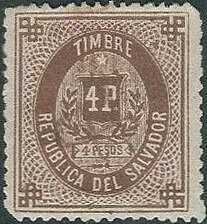Stamp: Numeral within shield (El Salvador 1883)
Numeral within shield (El Salvador 1883)
01 January (El Salvador ) within release Documents : 1883 issue, number in oval goes into circulation Stamp Numeral within shield face value 4 Salvadoran peso
| Stamp Numeral within shield in catalogues | |
|---|---|
| Forbin: | For: SV D5 |
Stamp is square format.
Also in the issue Documents : 1883 issue, number in oval:
- Stamp - Numeral within shield face value 25;
- Stamp - Numeral within shield face value 50;
- Stamp - Numeral within shield face value 1;
- Stamp - Numeral within shield face value 2;
- Stamp - Numeral within shield face value 4;
- Stamp - Numeral within shield face value 6;
- Stamp - Numeral within shield face value 8;
- Stamp - Numeral within shield face value 10;
|
Data entry completed
50%
|
|
|---|---|
| Stamp Numeral within shield in digits | |
| Country: | El Salvador |
| Date: | 1883-01-01 |
| Perforation: | 12 |
| Emission: | Revenue |
| Format: | Stamp |
| Face Value: | 4 Salvadoran peso |
Stamp Numeral within shield it reflects the thematic directions:
A leaf (pl.: leaves) is a principal appendage of the stem of a vascular plant usually borne laterally aboveground and specialized for photosynthesis. Leaves are collectively called foliage, as in "autumn foliage", while the leaves, stem, flower, and fruit collectively form the shoot system. In most leaves, the primary photosynthetic tissue is the palisade mesophyll and is located on the upper side of the blade or lamina of the leaf but in some species, including the mature foliage of Eucalyptus,palisade mesophyll is present on both sides and the leaves are said to be isobilateral. Most leaves are flattened and have distinct upper (adaxial) and lower (abaxial) surfaces that differ in color, hairiness, the number of stomata (pores that intake and output gases), the amount and structure of epicuticular wax and other features. Leaves are mostly green in color due to the presence of a compound called chlorophyll which is essential for photosynthesis as it absorbs light energy from the sun. A leaf with lighter-colored or white patches or edges is called a variegated leaf.
A number is a mathematical object used to count, measure, and label. The most basic examples are the natural numbers 1, 2, 3, 4, and so forth. Numbers can be represented in language with number words. More universally, individual numbers can be represented by symbols, called numerals; for example, "5" is a numeral that represents the number five. As only a relatively small number of symbols can be memorized, basic numerals are commonly organized in a numeral system, which is an organized way to represent any number. The most common numeral system is the Hindu–Arabic numeral system, which allows for the representation of any non-negative integer using a combination of ten fundamental numeric symbols, called digits. In addition to their use in counting and measuring, numerals are often used for labels (as with telephone numbers), for ordering (as with serial numbers), and for codes (as with ISBNs). In common usage, a numeral is not clearly distinguished from the number that it represents.
A star is a luminous spheroid of plasma held together by self-gravity. The nearest star to Earth is the Sun. Many other stars are visible to the naked eye at night; their immense distances from Earth make them appear as fixed points of light. The most prominent stars have been categorised into constellations and asterisms, and many of the brightest stars have proper names. Astronomers have assembled star catalogues that identify the known stars and provide standardized stellar designations. The observable universe contains an estimated 1022 to 1024 stars. Only about 4,000 of these stars are visible to the naked eye—all within the Milky Way galaxy.



